What an Autoimmune Disease Rash Means
Undiagnosed Conditions, Flares, and Steps to Take
Medically reviewed by Anita C. Chandrasekaran, MD
When the immune system is healthy, it protects the body from disease and infection. In autoimmune diseases, the immune system mistakenly attacks the cells, tissues, and organs of the body. Rashes can occur as part of these attacks.
An autoimmune disease rash can indicate a flare-up (times of increased disease activity that cause worsened symptoms) or may be the first symptom a person experiences before a diagnosis. Several autoimmune diseases, including psoriasis, lupus, and Sjögren’s syndrome, can cause rashes.
Continue reading to discover what autoimmune diseases have rash symptoms, why rash can be a first sign of autoimmune disease, tests to diagnose autoimmune disease from rash, and how to care for skin with autoimmune disease and rash.
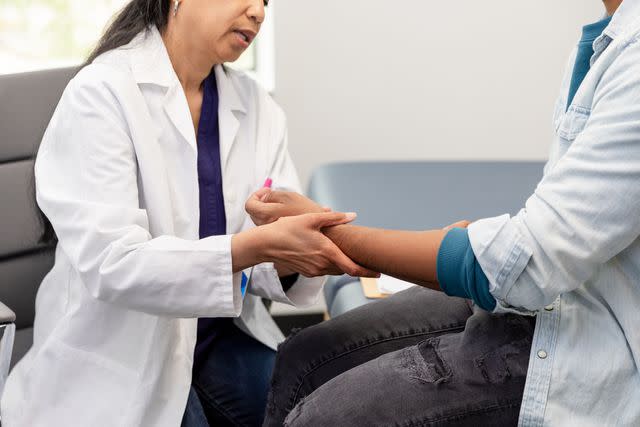
SDI Productions / Getty Images
List of Autoimmune Diseases With Rash Symptoms
The following autoimmune diseases have rash symptoms.
Psoriasis
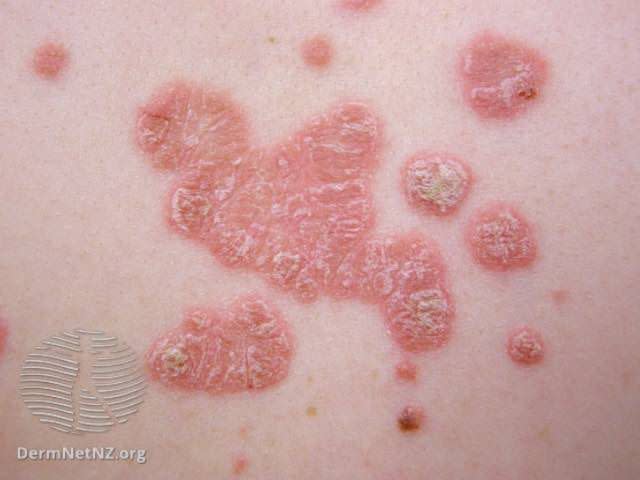
DermNet / CC BY-NC-ND
PsoriasisPsoriasis is an inflammatory skin condition in which an overactive immune system causes rashes or plaques to form on the skin. These rashes can occur anywhere on the body.
Different types of psoriasis—plaque, flexural, guttate, erythrodermic, and pustular—have different types of rashes.
Symptoms of psoriasis rashes by type are:
Plaque: For people with lighter skin tones, this causes salmon-colored plaques with a silvery-white scale on top. For people with darker skin tones, psoriasis plaques may be violet with a gray scale. Areas of lighter or darker pigmentation may be seen rather than reddening. Plaques usually affect the knees, elbows, trunk, and scalp.
Flexural or inverse: Patches with no scaling form in the folds of skin, such as armpits, genitals, and under breasts. On lighter skin, they appear as red or pink patches. On darker skin, they may be purple, brown, or darker than the surrounding skin.
Guttate: Causes small teardrop-shaped red and scaly spots on the arms, legs, and trunk.
Erythrodermic: Causes similar symptoms to plaque psoriasis, except the rash covers nearly the entire body
Pustular: Small, pus-filled blisters develop. These may be localized on the palm, fingers, or toes or may be generalized.

Reproduced with permission from © DermNet New Zealand and © Waikato Hospital www.dermnetnz.org 2023.
Lupus

DermNet NZ
Lupus is a chronic autoimmune disease that occurs when the immune system attacks healthy tissues and organs. An unpredictable illness, lupus can many body areas, including the skin, the joints, the kidneys, blood cells, the heart, and the lungs. Rashes occur in lupus when the immune system targets skin cells.
Symptoms of lupus rashes include:
Malar rash: Appears on the face and is known as the butterfly rash because its shape resembles a butterfly
Red or discolored coin-shaped plaques on the skin that can cause permanent discoloration and scarring
Thick or scaly patches that can burn or itch
Open sores in the mouth
Hair loss (alopecia)
Hives that don't respond to antihistamines
Malar rash is a distinct sign of lupus and is one of the more common lupus rashes. It is red and /or has raised papules. The malar rash can be mistaken for rosacea, which is a chronic inflammatory skin disease. However, the malar rash spares the nasolabial folds (the creases on the face extending from the nose down to both sides of the mouth), which rosacea does not.
Sjögren’s syndrome
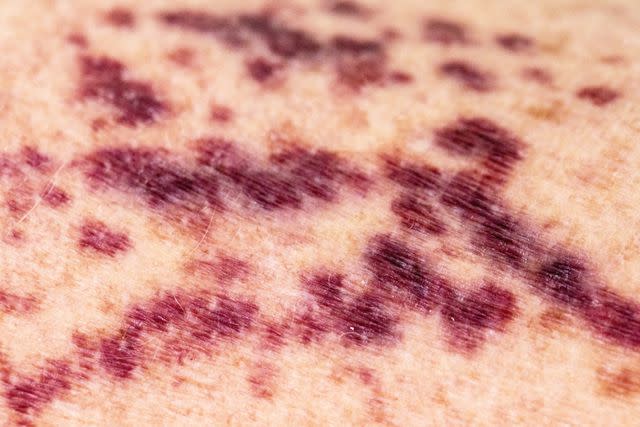
Jodi Jacobson / Getty Images
Sjögren’s syndrome is a systemic autoimmune disease that typically causes dry eyes and dry mouth but can also cause rashes.
Symptoms of Sjögren’s syndrome rashes include:
Dry skin
Ring-shaped red to purple patches that can become scaly or bleed
Red to purples dots that look like blood under the skin, known as petechiae (may be brown or black with darker skin tones)
Vasculitis, a rash that occurs when blood vessels leak under the skin that may itch or burn
Vasculitis
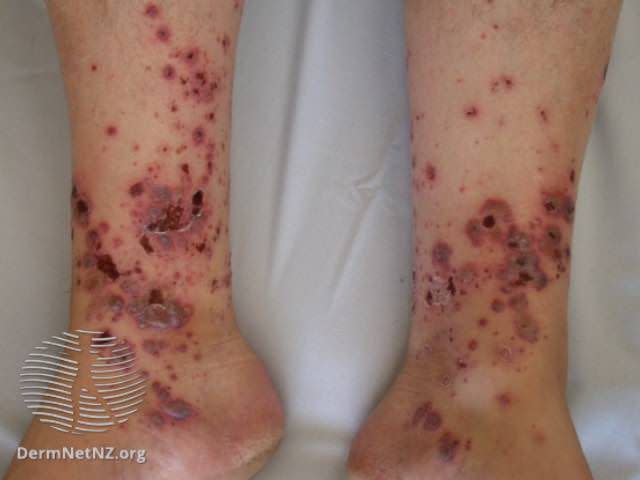
DermNet / CC BY-NC-ND
Vasculitis causes inflammation of the vascular system, or blood vessels, of the body. Rash is one of the most common symptoms of vasculitis.
Symptoms of vasculitis rashes include:
Red or purple bruise-like spots on the skin, known as purpura (may be less obvious on brown or black skin)
Red dots that become bumpy or look like blisters
Ulcers (open sores) on the skin that may bleed or itch
Bullous Pemphigoid
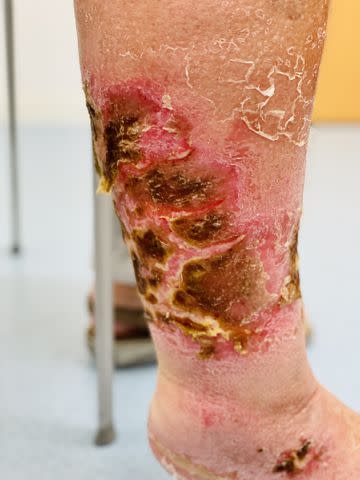
C5C / Getty Images
Bullous pemphigoid is a rare disease that affects the skin and causes blistering. It typically occurs in people over the age of 70.
Symptoms of bullous pemphigoid rashes include:
Itchy skin
Hives with blisters
Plaques with blisters on top of them
Dermatomyositis
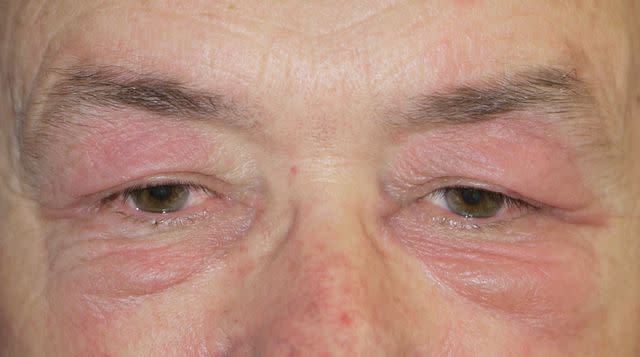
Reproduced with permission from © DermNet dermnetnz.org 2023.
Dermatomyositis causes chronic muscle inflammation that can lead to muscle weakness and pain. Often, the first sign of the disease is a rash followed by muscle weakness. However, that is not always the sequence.
Symptoms of dermatomyositis rashes include:
Patchy areas of red or purple skin on sun-exposed areas, such as the eyelids, joint areas, such as the knuckles, or chest/back
On black skin, may show lighter or darker patches instead of red or purple
Swelling in the rash area
Swollen, red areas around the fingernails or calcinosis cutis (hard lumps of calcium that form under the skin)
Multiple Sclerosis
In multiple sclerosis (MS), the immune system attacks the myelin sheath (protective covering of the nerves). Although people with MS do not typically experience a visible rash, they may experience chronic itching. MS symptoms include itching, mainly on the hands, feet, face, and scalp.
Why Rash Can Be a First Sign of Autoimmune Disease
Autoimmune diseases affect the entire body. The skin often reflects what is occurring internally. A body that is inflamed from the immune system attacking it may develop rashes as an outward sign of widespread inflammation.
When a rash occurs that appears to be autoimmune or has no other explanation, a healthcare provider will examine it along with other symptoms and may run tests to determine its cause.
Autoimmune diseases, like lupus or bullous pemphigoid, are known to affect the skin. Their associated rashes are part of the disease symptoms and can occur with flares or be the first noticeable symptoms. Sudden blistering may be a sign of bullous pemphigoid, and tests will be run accordingly.
Someone who experiences the butterfly rash will likely be tested for lupus. People with dermamyositis will experience rashes before experiencing muscle weakness.
Psoriasis rashes are distinct enough that when a healthcare provider views them, they can often make a diagnosis based on skin symptoms only.
Thyroid Hormones & Rashes
The thyroid produces hormones that regulate skin cell production and turnover. There is some evidence that the thyroid may play a part in autoimmune rashes, especially in the case of autoimmune diseases like hypothyroidism (underactive thyroid) and hyperthyroidism (overactive thyroid).
Testing Rash to Diagnose Autoimmune Diseases
Autoimmune diseases are not always easy to diagnose. While blood tests and a health history can often narrow down the cause of symptoms and point to certain autoimmune diseases, sometimes a biopsy may be necessary to help determine the cause of the rash.
Skin biopsy tests take a sample of tissue to analyze in the lab. They may include:
Shave biopsy: The top few layers of the skin will be removed with a razor or scalpel and tested. This is used on rashes that only affect the top layer of skin.
Punch biopsy: A punch biopsy uses a round blade to take a deeper sample of the skin and is more accurate when diagnosing bullous pemphigoid. This method may also be used to test other rashes, such as those with discoid lupus.
Skin Care With Autoimmune Disease and Rash
People with autoimmune diseases that cause rashes can take skin care steps to lessen symptoms and prevent further flares of rashes.
In general, treating the underlying disease can help prevent flares, which can lead to a recurrence of symptoms like rashes.
Topical creams can help with psoriasis symptoms along with oral medications. In some cases, ultraviolet (UV) light exposure can also help lessen plaques.
For sun-sensitive autoimmune diseases such as lupus, avoid direct sunlight, especially during the sun’s peak hours from 10 a.m. to 3 p.m. Wear protective clothing such as hats or clothes made with high-quality fabrics, and use sunscreen.
Blisters associated with bullous pemphigoid may resolve on their own, but topical creams can help with itching and heal the blisters.
Summary
Autoimmune rashes may indicate a flare of an autoimmune disease or may be the first sign that someone has an autoimmune disease. Autoimmune diseases associated with rashes include psoriasis, lupus, Sjögren’s syndrome, vasculitis, dermatomyositis, and bullous pemphigoid.
These rashes all vary from red and purple spots known as petechiae to a butterfly rash on the face to plaques and lesions that can cause scarring and discoloration. Rashes can also cause itching and blistering.
In many cases, rashes are an outward sign of internal inflammation and are often the first sign of an autoimmune disease. Tests to determine the rash origin include blood tests and skin biopsies.
Medications and topical creams can treat autoimmune rashes and the underlying disease. Avoiding the sun can also help with symptoms in some instances.
Read the original article on Verywell Health.

